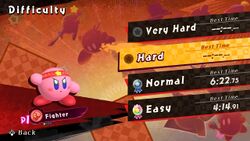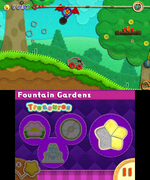Difficulty is a term that typically refers to adjustable levels of challenge in video games. Difficulty usually comes in terms of defined parameters (such as "Easy", "Normal", "Hard", etc.), as a number rating, or as a gradual meter that can be moved up and down. Basic elements of gameplay typically affected by difficulty include the durability and/or number of enemies, the amount of damage enemies can do, the speed and behavior of enemy attacks and/or stage hazards, and the durability of the playable character(s). Difficulty can also be applied indirectly, by imposing stricter or more lenient requirements on players, such as time limits or score thresholds, or could involve setting entirely new restrictions. Another indirect means of enforcing difficulty involves encouraging players to aim for 100% completion of the game, which usually involves performing optional tasks that are often more difficult than the required sections of gameplay. Players also frequently opt to apply self-imposed restrictions on their gameplay which - while not strictly enforced by the games - can significantly increase the difficulty nonetheless, with popular examples being 'no-damage runs' or speedruns.
In the Kirby series, difficulty is handled in a variety of different ways. While the series in general is catered toward ease of play, there are often many options, Sub-Games or other modes and restrictions that allow for much more difficult gameplay. The most common example of this is the inclusion of Extra Modes and Boss Endurances which are unlocked after the Story Mode is completed. Many Sub-Games also come with rigid difficulty options which the player can select before playing, and often need to be unlocked. Whenever a Computer Player is involved, the player can often opt to change its difficulty level, which will influence its speed and decision-making.
Difficulty by game[edit]
The following goes over how notable games in the Kirby series handle difficulty selections in their main game modes. For examples of how difficulty is handled in Sub-Games, check each individual Sub-game article.
Kirby's Dream Land[edit]
- Main article: Extra Mode
When the main game of Kirby's Dream Land is completed, the player is presented with a special code consisting of a combination of button inputs (↑, A, and Select) which activates a different version of the game on the title screen called 'Extra Game'. This version of the game plays much like the original, but replaces a lot of enemies with more aggressive versions and changes enemy behavior in general to be more unforgiving. Bosses and Mid-Bosses in particular have revised attack patterns which are generally tougher to avoid.
Additionally, there is a hidden configuration mode that allows the player to specify how much health Kirby has, in addition to how many extra lives he can have at maximum. This makes it possible to specify a game where the player can get a Game Over from a single hit.
Kirby's Adventure / Kirby: Nightmare in Dream Land[edit]
Much like its predecessor, Kirby's Adventure features an Extra Game, which can only be unlocked by attaining 100% completion in the main game. However, the only differences are that Kirby only has three bars of health as opposed to the full six, the difficulty of all sub-games is raised to Level 3, and the player's progress cannot be saved.
In Kirby: Nightmare in Dream Land, it is possible to save during the Extra Game. However, the addition of Meta Knightmare adds a timed run-through of the game with similar difficulty and the inability to save.
Kirby's Dream Course[edit]
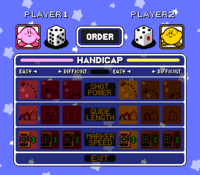
In the 2P Game menu for
Kirby's Dream Course, players can set handicaps for themselves to make certain guides for making shots more or less difficult to use.
In the single-player courses in Kirby's Dream Course, difficulty can depend on which medal the player is aiming for, as earning a higher medal requires fewer overall shots in each course.
In the 2P Game, players can choose handicap settings for themselves to adjust how difficult it is to accurately make shots.
Kirby's Avalanche[edit]
In the Competition Mode of Kirby's Avalanche, there are three difficulty levels, listed as "Easy", "Normal", and "Hard". Each difficulty selection determines which opponents Kirby will face and how skilled they will be, and only by playing Normal or Hard mode can the final boss (King Dedede) be faced and the game completed.
In 1P vs. 2P and Practice Mode, a handicap can be set for each player, which increases the speed at which Puyos fall. 1P vs. 2P features Mild, Medium, Spicy, Hot, and Cajun as the difficulty options. In Practice Mode, there is only Mild, Spicy, and Cajun; selecting Spicy difficulty will add 40,000 points to the player's total score, and selecting Cajun will add 90,000 points.
Kirby's Dream Land 2 / Kirby's Dream Land 3 / Kirby 64: The Crystal Shards[edit]
- Main article: Bad ending
All three of these games take a slightly different approach to difficulty from the rest of the series. While not featuring extra games, they each have a special requirement which must be met, or the adventure will end prematurely with a bad ending. To avoid this, Kirby must locate all of the special collectable items in the regular stages, which are usually either well-hidden or require completing a specific task to obtain before defeating the 'last' boss. This will allow Kirby to proceed to the real final level and face the true final boss to get the good ending.
Kirby's Block Ball[edit]
Each regular stage has a score threshold called the 'Borderline score'. The player is challenged to exceed this score on each stage in order to access the final stage and complete the game.
Kirby Super Star / Kirby Super Star Ultra[edit]
Each game on the main corkboard menu is given a difficulty rating which ranges from one star to seven. While there is little variable difficulty in the games themselves, this distinction does afford the player an understanding of which games are considered more difficult than others.
Kirby's Star Stacker[edit]
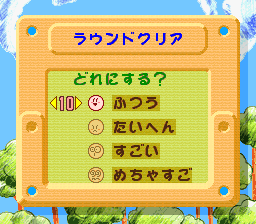
The various difficulty levels, as they appear in the Super Famicom version of Kirby's Star Stacker.
In Kirby's Star Stacker for the Game Boy, there are five different levels of difficulty, which affect the starting gameplay speed and the initial block formation. (In the Round Clear mode, the initial block formation is fixed for each round instead). These are, in ascending order, Normal, Hard, Very Hard, Super Hard, and Insane. Initially, only the first four levels of difficulty are available and Insane needs to be unlocked individually in each mode. The Japanese difficulties have slightly different names: やさしい (Easy), ふつう (Normal), たいへん (Hard), すごい! (Very Hard, or literally "Cool!"), and めちゃすご! (Insane, or literally "Super Cool!")
In the Super Famicom version, these are simplified to only four levels of difficulty: ふつう (Normal), たいへん (Hard), すごい (Very Hard), and めちゃすご (Insane). The main story mode initially has one level of difficulty, but upon defeating Gryll, "Pro Mode" opens up, which makes the opponents more difficult.
Kirby Tilt 'n' Tumble[edit]
The extra game present in this title allows the player to play through the stages again on a tighter time limit and with faster enemies and hazards to contend with.
Kirby Air Ride[edit]
While there are no difficulty selections for game modes, the CPU can have their difficulty adjusted to make them more or less aggressive. In addition, several of the Checklist objectives encourage the player to perform certain challenging feats, which often involve beating various times on courses.
Kirby: Canvas Curse[edit]
- Main article: Medal Swap
Kirby: Canvas Curse offers a number of different unlockable characters who the player can choose from in addition to Kirby. These characters often come with their own restrictions, such as increased size, decreased stamina, or decreased utility.
Kirby: Squeak Squad[edit]
Kirby: Squeak Squad's Extra Game presents an optional challenge to the player - collecting all the Treasure Chests in the game in the fastest time possible.
In Kirby's Epic Yarn, a slightly different approach to difficulty is taken with that Kirby and Prince Fluff do not use a health system at all, and taking damage will instead only cause either character to lose beads and get knocked back. Obstacles that are normally regarded as fatal hazards including bottomless pits and crushers will only cause either Kirby or Prince Fluff to be carried by Angie back to the stage, dropping several beads along the way.
As such, an optional challenge that the player can take is to get a gold medal on all stages, which requires them to collect many beads while not taking damage as much as possible. Notably, unlocking all the extra stages in each level requires reaching a bead threshold much higher than a gold medal during boss stages, which awards the player with an Area Patch for the first extra stage if done so.
The 3DS port Kirby's Extra Epic Yarn adds a difficulty option called Devilish Mode, which increases the difficulty by employing a life meter and having a Devil spawn to hound Kirby throughout the stage with different attacks. By not taking as much damage as possible, the player is rewarded with Life Pieces which contribute to unlocking new furniture.
Kirby Mass Attack[edit]
The player's performance on each stage is graded with a colored star at the end depending on how well the Kirbys were handled. A bronze star is awarded if no Kirbys were lost, while a silver star is awarded if no Kirbys were KO'd. Lastly, a gold star is awarded if no Kirbys were harmed throughout the stage. Having gold stars on all stages is required for 100% completion, which presents a further challenge to the player. Additional difficulty comes from collecting all the Medals and Rainbow Medals in every stage, with the latter being mandatory to unlock Necro Nebula and complete the main story.
Kirby's Return to Dream Land / Kirby's Return to Dream Land Deluxe[edit]
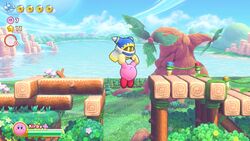
In
Kirby's Return to Dream Land Deluxe, enabling "Helper Magolor" allows
Magolor to step in and rescue Kirby and his friends if they fall into a
bottomless pit.
An Extra Mode is present which can be unlocked after clearing the Main Mode. This playthrough makes a number of changes to the game, including making enemies more aggressive and greater in number, decreasing the maximum stamina of the playable characters, and increasing the power and giving new moves to Bosses and Mid-Bosses. In addition, a new boss called HR-D3 is inserted after the defeat of Metal General EX at the end of the Egg Engines level.
In Kirby's Return to Dream Land Deluxe's Story Mode, there is an easier difficulty setting which can be enabled at the start of the game, called "Helper Magolor". With this option enabled, Magolor will accompany Kirby and friends on their adventure in Story Mode. Helper Magolor will do the following for the team:
- Give all player characters a special potion that doubles their maximum health.
- Rescue anyone who falls into a bottomless pit (if multiple fall at once, the ones who fall later will Space Jump to where the first one was picked up by Magolor).
- Appear during boss and mid-boss fights to give Kirby an Ability Star if he does not have a Copy Ability equipped (if Kirby loses his Copy Ability and is unable to recover it, Magolor will give that specific ability back).
- Appear during boss and mid-boss fights to give Kirby a food item to help recover his health.
- Appear during the Goal Game to give all players 1-3 food items depending on what number they land on.
Having Helper Magolor enabled also causes certain stage hazards to move slower and Super Ability timers to last longer.
Magolor will also appear during the Festival dance whenever it happens, though this is purely cosmetic. Helper Magolor cannot be enabled for the remainder of the Another Dimension level due to his act of betrayal in the "Let Me Explain Everything" cutscene that plays prior to said level. If enabled sometime before the cutscene starts, then only the doubled health will stick around for the duration of the level.
In addition, Kirby's Return to Dream Land Deluxe makes its Extra Mode more challenging by adding more enemies and other hazards to the stages that were not present in the original Extra Mode, as well as replacing most food and all Maxim Tomatoes outside of boss stages with Point Stars and normal food, respectively.
Kirby's Dream Collection Special Edition[edit]
The New Challenge Stages game contained in this collection challenges the player to obtain the King Trophy by earning platinum medals on each stage. To do this requires nearly flawless performances in the stages.
Kirby: Triple Deluxe / Kirby: Planet Robobot / Kirby Star Allies[edit]
Each of these games feature most of their more difficult content in unlockable extra modes which feature different characters than Kirby. In the main games, the player is encouraged to find the hidden collectibles or press hidden switches to unlock extra stages which tend to be more challenging than the main stages.
In Kirby Star Allies, there is an option accessible from the Settings menu called "Display tips", which is on by default. When this is active, the game will offer clues to the player on how to solve certain puzzles in the Story Mode, and will also give tips on the game's loading screens. Turning this off will remove most of these clues and all the loading screen tips. If turned on, these loading screen tips will start to appear less frequently after reaching the Fortress of Shadows Jambastion.
Kirby Fighters Deluxe / Kirby Fighters 2[edit]
In the single-player mode of Kirby Fighters Deluxe, there are four selectable difficulties of Easy, Normal, Hard, and Very Hard. These paths increase the difficulty of each opponent fought, alongside giving Kracko and Team DDD more attacking options.
The Single-Handed Mode in Kirby Fighters 2 also features these same four difficulties.
In both games, regular matches allow the player to determine the difficulty level of CPU opponents.
Dedede's Drum Dash Deluxe / Kirby's Blowout Blast[edit]
These games challenge the player to earn a platinum trophy in each stage in order to unlock the extra stages. Likewise, earning platinum on those stages offers additional rewards.
Kirby and the Rainbow Curse[edit]
Much like in Kirby's Epic Yarn, this title grades the player based on how many stars were collected, with each stage giving out a medal ranging from bronze to gold. Collecting medals, along with other qualifications, allows the player to unlock Challenge Mode stages, which vary in difficulty.
If the player loses four lives in a row in the same stage, they will get the option to skip to the next stage.[1]
Team Kirby Clash Deluxe / Super Kirby Clash[edit]
These games feature lists of Heroic Missions, many of which task the player to win encounters with specific conditions. Additionally, the player can modulate the difficulty by using different equipment or support items.
Kirby Battle Royale[edit]
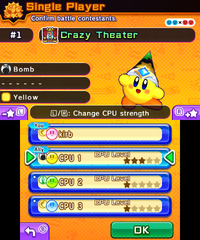
The CPU difficulty selection menu in
Kirby Battle RoyaleMuch like Kirby Air Ride, this title has CPU players whose difficulty can be adjusted. Changing CPU difficulty affects their behavior across different battles (they will actively picked up downed players and throw them into hazards on higher levels, for example). In Dedede's Cake Royale, the CPU difficulty gradually increases with each league, with easier CPU opponents in the Beginner's League and the hardest in the Platinum League. The game also keeps an achievement system which encourages the player to perform certain challenging feats in the various games.
Kirby and the Forgotten Land[edit]
In Kirby and the Forgotten Land, two difficulty settings are introduced, which are selected when first starting a game file, but can be changed later anytime when outside of stages (or lowered or increased in a stage if Kirby is either defeated too many times or clears an area relatively easily). These difficulty settings are called Spring-Breeze Mode and Wild Mode. Spring-Breeze Mode is the easier of the two, giving Kirby and Bandana Waddle Dee more health (400 HP in Spring-Breeze Mode VS. 250 HP in Wild Mode), reducing the number of enemies on the field in some stages, and reducing boss health more sharply when defeated. Wild Mode features more and tougher enemies, but offers greater rewards. In particular, 50 extra Star Coins are rewarded for completing a regular stage in Wild Mode, and 10 are awarded for completing a Treasure Road stage in Wild Mode.
Additionally, in Spring-Breeze Mode, Star Bullets and Slides will curve more strongly toward targets than in Wild Mode. Spring-Breeze Mode also allots Kirby 30 extra seconds to complete Treasure Road stages (but the target time remains the same).
Spring-Breeze Mode difficulty selection in the demo
Wild Mode difficulty selection in the demo
Kirby's Dream Buffet[edit]
In Kirby's Dream Buffet, the player can choose from four difficulty levels for all CPUs - Sweet, Normal, Spicy, and Extra Spicy. CPUs on harder difficulties tend to play more aggressively, especially being more likely to attack non-CPU players with Copy Food Abilities in Battle Royale as well as having a higher tendency to push them away in Races.
All game modes excluding Free Rolling grant an additional bonus multiplier independent of the results tally to the total Strawberries collected by the end of a match if the player has chosen either the Spicy or Extra Spicy difficulties:
- Spicy Bonus - × 1.20
- Extra-Spicy Bonus - × 1.25
If choosing modes in-between matches via Change Event Type, the previously selected CPU difficulty will be still carried over, and cannot be changed until the player exits to the Home Table.
References
- ↑ Kirby and the Rainbow Curse digital manual, section 9
| Game design and mechanics of the Kirby games |
|---|
| | Game design | | | | Recurring game mechanics and elements | | | | Recurring game modes and menus | | | | Meta | |
|
| Kirby's Dream Course |
|---|
| | Characters | | | | Single-Player Courses and Holes | | | | Two-Player Courses and Holes | | | | Copy Abilities | | | | Enemies | | | | Course Obstacles | | | | Extra | |
|
| Kirby's Dream Land 3 |
|---|
| | Characters | | | | Levels and stages | | | | Copy Abilities | | | | Enemies | | | | Mid-Bosses | | | | Bosses | | | | Items | | | | Heart Star characters | | | | Extra | |
|
| Kirby: Canvas Curse |
|---|
| | Playable characters | | | | Levels and Stages | | | | Copy Abilities | | | | Enemies | | | | Bosses | | | | Items and objects | | | | Extra | |
|
| Kirby Mass Attack |
|---|
| | Characters | | | | Levels and stages | | | | Story Mode enemies | | | | Sub-Game-exclusive enemies | | | | Mid-Bosses | | | | Story Mode Bosses | | | | Sub-Game-exclusive bosses | | | | Sub-Games | | | | Extra | |
|
| Kirby: Triple Deluxe |
|---|
| | Characters | | | | Levels and stages | | | | Bosses | | | | Mid-Bosses | | | | Copy Abilities | | | | Enemies | | | | Sub-games | | | | Items and objects | | | | Kirby Fighters Battle Stages | | | | Dedede's Drum Dash stages | | | | Extra | |
|
| Kirby: Planet Robobot |
|---|
| | Characters | | | | Levels and stages | | | | Bosses | | | | Mid-Bosses | | | | Copy Abilities | | | | Enemies | | | | Sub-Games | | | | Kirby 3D Rumble levels | | | | Items and objects | | | | Extra | |
|
| Kirby Star Allies |
|---|
| | Characters | | | | Levels and Stages | | | | Copy Abilities | | | | Friend Abilities | | | | Friend Actions | | | | Standard Friends | | | | Dream Friends | | | | Regular enemies | | | | Mid-Bosses | | | | Bosses | | | | Items and objects | | | | Sub-Games | | | | Extra | |
|


